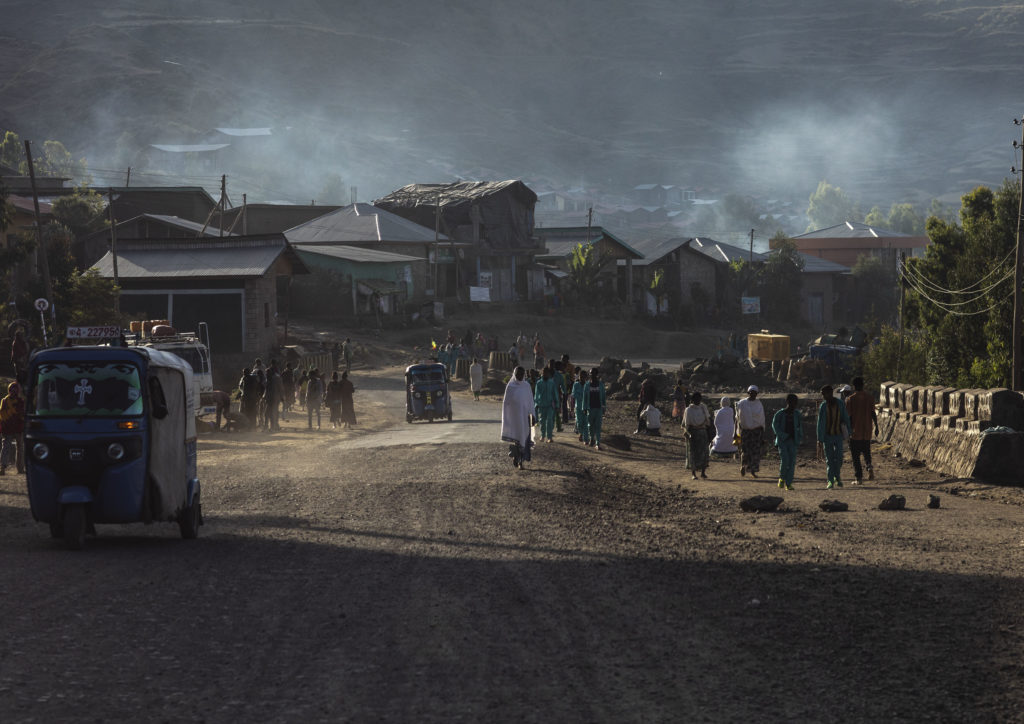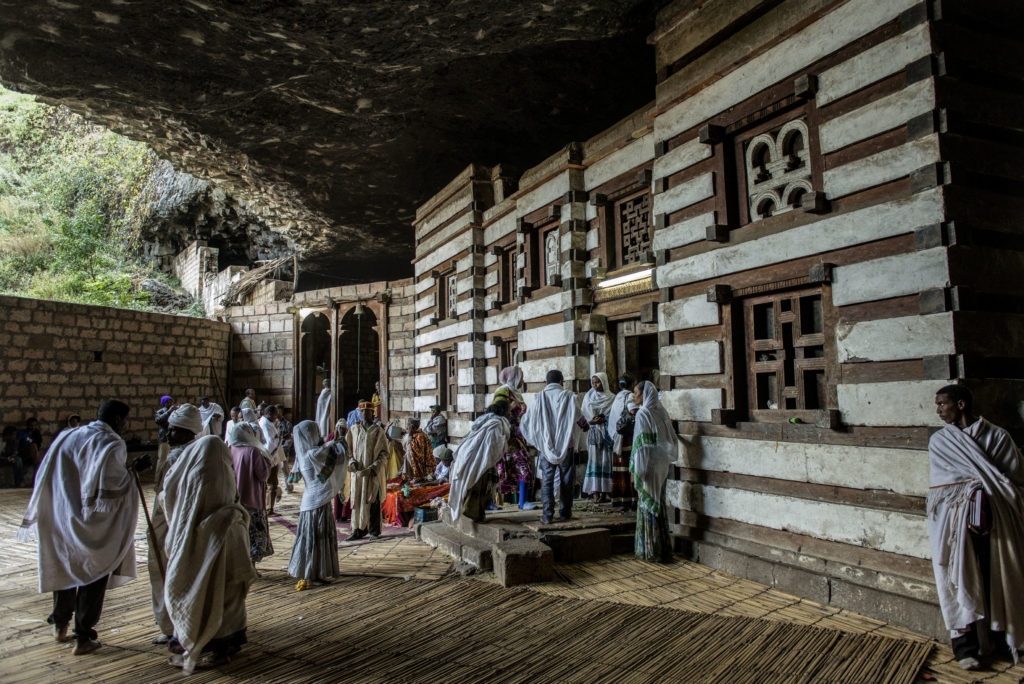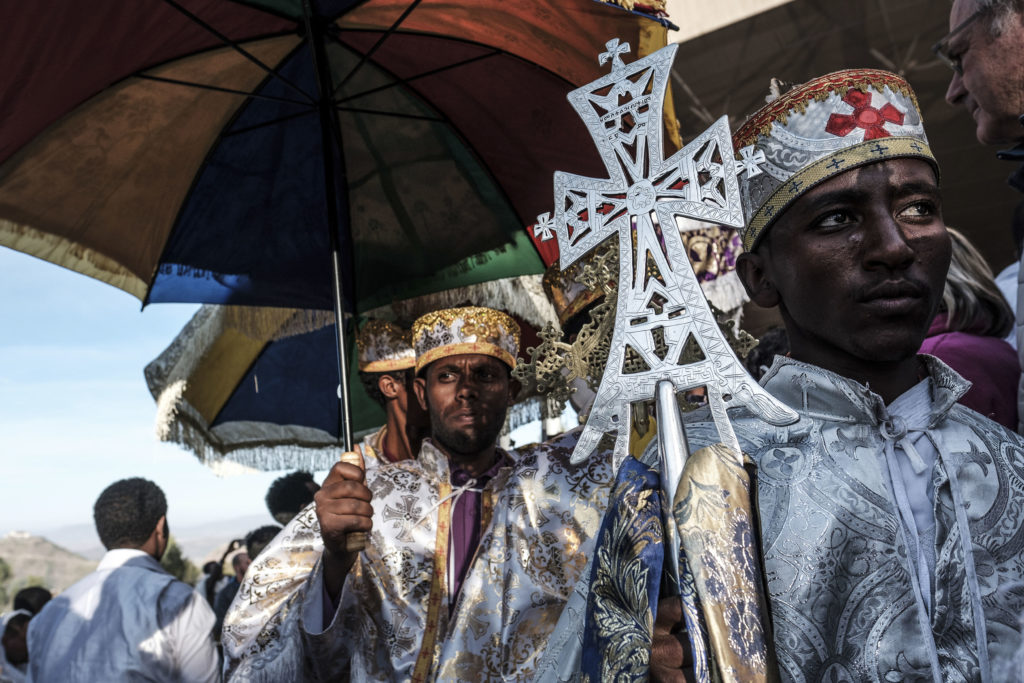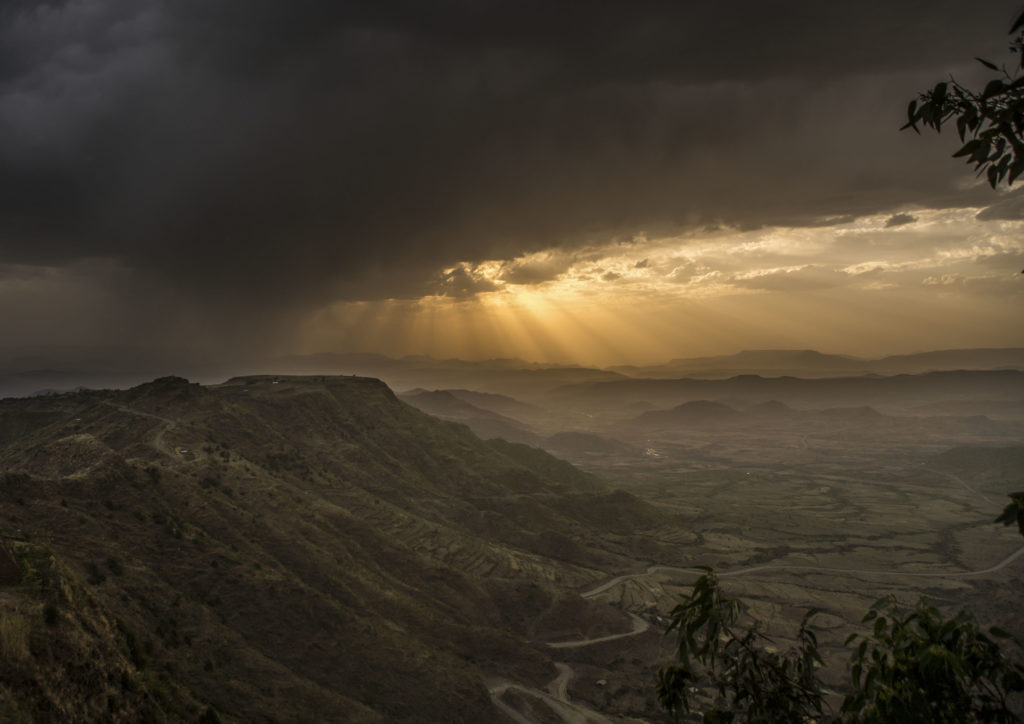Sacred site: The monolithic rock-cut church of Saint George in Lalibela, Ethiopia is one of 12 churches there hewn from rock. (Eric Lafforgue/Art in All of Us/Corbis/Getty Images)
“The palpable weight of history here makes one’s personal problems and anxieties seem trivial”
It’s unclear to me exactly why I am at the airport about to board a plane to Ethiopia. But this trip is, at least partly, the result of the fact that I am undergoing a mid-sabbatical crisis.
Faced with a panic about how I hadn’t yet done anything at all during my sabbatical, I apparently remembered that I had always wanted to see the carved stone churches of Lalibela, and immediately booked a flight. For that week.
My lack of planning meant I had done little research about the churches themselves, so when I reached the airport lounge I attacked a bottle of wine and a hefty book about the churches, in that order.
The churches of Lalibela were carved on the instruction of King Lalibela shortly after the forces of Islam swept across North Africa in the seventh century CE. Their presence meant pilgrimage to the Holy Land was no longer possible for the highly religious residents of Ethiopia. Being a thoughtful king, apparently very concerned with his subjects’ spiritual wellbeing, Lalibela built them a sort of secondary Jerusalem they could visit instead.
Anyway, the king created a church for each of the 12 major religious sites of the Holy Land by carving each out of solid rock. Thus there is one for Bethlehem, one for Calvary and so on. I suspected that I was going to love it.
It was surprisingly cold in the airport in Addis Ababa. I was greeted by a concierge called Francis, who wore an outfit of what seemed to be a Victorian admiral’s jacket (complete with gold braid) and jeans. Francis soothed my stressed brain with a large whisky and soda and then took me to the salmon-and-green dining room. Later Francis woke me with a crisp knock on the door and a cup of excellent local coffee in time for my flight to Lalibela. This, I felt, was where the real adventure began.
Addis feels like a modern African city, but it seemed as if this small, prop-driven plane was now taking us back in time. The landscape below is composed of hundreds of enormous, savagely jagged mountain ranges. Their sheer brutality is perhaps a reason why Ethiopia was never colonised, discounting a five-year occupation by the Italians.
As we wind our way up the road from the airport to Lalibela, vultures or eagles of some kind with an eight-foot wingspan flash past the car.
 Religious community: Morning in Lalibela. (Eric Lafforgue/Art in All of Us/Corbis/Getty Images)
Religious community: Morning in Lalibela. (Eric Lafforgue/Art in All of Us/Corbis/Getty Images) The Yemrehana. (Francois Dommergues/Getty Images)
The Yemrehana. (Francois Dommergues/Getty Images)
I am told that the Chinese are not welcome here because they built this road. It is indeed in bad shape: heavily potholed, and looking at least 20 years old. “When did they build the road I ask the driver?” “Eighteen months ago,” he replies.
But one does not come to Lalibela for the airport or the roads. One comes for religion. And in this regard, it does not disappoint. The air of the town is heavy with religion and faith. Every man older than 35 looks like a prophet. Perhaps it’s the beards and walking sticks.
Ethiopian Christianity is fascinating. Being cut off by the Muslim conquest in the seventh century meant that they were isolated not only from the Holy Land, but all other Christians too. That means no Council of Nicaea. No Council of Trent. No Popes. No Rome. And certainly no Reformation. This is Christianity much as it was in early Israel, when it was more of a Jewish sect than a separate religion. It feels that way too.
The Ethiopian Orthodox Church has its own Bible. Written in an ancient language called Ge‘ez, it has no New Testament.
My clean, simple hotel room has a wonderful view of the mountain above Lalibela. I sit listening to the birds, chickens and children, looking at the mountain into which Biete Maryam church has been dug. What may or may not be bat hawks and imperial eagles (my guide book isn’t clear) twist in the clear sky. It is almost unbearably peaceful.
I sit with my bare feet on the rail of the balcony, drinking gin and coke (it’s all they have) without ice.
The next day I head into the town to meet my guide. His name is Andy, which is a little disappointing. I was hoping for a guide named Zedekiah or Ezekial. However, Andy seems pleasant and very knowledgeable. The centre of the town is filled with several dozen brightly decorated tuk-tuks, painted aquamarine, lemon-yellow and bright pink.
We set off for Debra Zeit, or Mount of Olives in English. It is huge, and silent. Having been to Israel, I strangely feel that this place must be closer to the Mount of Olives in biblical times than the one I saw there, which was full of traffic lights and ice-cream sellers.
Here, religion isn’t something tacked on to life: it runs through every aspect of it. Andy says that 99% of people are churchgoers. There are 252 days of fasting each year. Priests train for 15 years.
The Mount of Olives is encrusted with juniper and wild olive trees hundreds of years old, dripping in moss. A wizened nun begs at the bottom of the path.
The palpable weight of history here makes one’s personal problems and anxieties seem trivial.
The next day Andy says we will visit a 1000-year-old church inside a cave that nobody ever goes to. Because around here, a 1000-year-old-church inside a cave isn’t a big deal. The drive is about half an hour from Lalibela. The road is lined with wheat fields.
It seems to be harvest time. Everywhere people are threshing wheat — or is it barley? — with oxen. It is like being on the set when a historical “re-enactment” is being shot for the history channel about food-production techniques in the ancient world.
The 1000-year-old church that nobody visits is called Yemrehana Krestos. It is a two-storey church built of wattle and stone, inside a cave. It is striped in broad swathes of cream and brown paint, and has (sort of) battlements on the top bit.
When we go inside, I’m struck by a smell that I will come to recognise as one unique to these Ethiopian churches. It is a mix of incense, smoke, wood, damp and carpets, older than any building in the United States. It smells like time, if time were a fragrance made specifically for a very demanding client.
This smell is more than a smell. It’s a time-travel device. It drags you into a period when time itself wasn’t that important. What was important was God. Death. Reward and punishment.
Like all the churches, it has a Holy of Holies behind the altar, where the spiritual relics unique to that church are kept. In this case, there is a cross that the monk says is “really old. Not like the church”. Which makes it pretty old.
 Holy men: Ethiopian Orthodox priests attend the Christmas celebration at Beite Maryam church in Lalibela. (EDUARDO SOTERAS / AFP)
Holy men: Ethiopian Orthodox priests attend the Christmas celebration at Beite Maryam church in Lalibela. (EDUARDO SOTERAS / AFP) Pilgrims rest at a camp site in the town. (EDUARDO SOTERAS / AFP)
Pilgrims rest at a camp site in the town. (EDUARDO SOTERAS / AFP)
We stop for traditional coffee. Andy and I chat. Somehow (these things happen in Lalibela), it is discussed where he will be buried. Andy was born here. Everyone he knows will be buried here. He adds that he has 11 siblings who were born in Lalibela, and all of them live there.
On the way back to town we drive in silence. It is hot and dusty. We pass old men on donkeys, women chattering in groups and a dead cat.
It is getting dark. We pass two separate accidents but everyone seems calm. Life is fragile here. People do not fool themselves into thinking that they can avoid death and disaster through money, planning and foresight. The views are massive. The sky is gigantic.
The next day I find myself sitting again on the balcony of my room, this time watching a thunderstorm unfold over the mountain facing the hotel. I climbed the mountain this morning. It was incredible. There are hermit monks and nuns living in tiny caves they have carved out of the face of the rock, all the way up.
The mountain smelled really nice. The air was cool, because of the altitude. The only sounds were the wind in the blue-gum trees far below. On the lower part of the mountain there are small clusters of houses that look strangely Alpine.
The rain comes down hard. The drops have a tropical heft and weight to them. They sting the ground, and then disappear into the red dust. My gin and coke has ice in it today.
The churches are so many, and the facts about them so numerous, that I struggle to process them all. Each church is carved down into the ground. Nobody is sure why; perhaps so as to be invisible to potential attackers or to avoid wind erosion.
The creators of these masterpieces dug three or four storeys down and then carved an entire church out of the remaining rock in the middle. It must be the hardest way to make a church ever devised.
I hear that if one obtains permission from one of the senior priests, one can attend the Friday dawn service inside the Biete Lehem church. Despite a slight hangover, I’m there at 4.00am. The night is mediaeval dark and the rock walls of the church are damp. People have been walking through this narrow door for almost two thousand years to listen to the exact words that I’ll be hearing. This liturgy hasn’t been changed to “keep up with the times” or to “take into account the changing nature of our society”.
The trainee monks read the first part of the service. These are the youngsters — not even 50 years old. They stumble over the words. As the service goes on, the more experienced priests take charge. The Ge‘ez words are melodic and moving.
After about an hour, one of the older priests approaches me and offers me one of the long staffs that I’ve seen people here carrying. I see now what they are for — to support oneself during the long services.
At the back of the church some of the very old monks slump halfway between sleep and prayer, perhaps both. They rock back and forth to the chanting.
On my last day in Lalibela, Andy tells me that he’s going to take me to a church where you can be healed of any ailment. I’m interested. Perhaps I could get them to care of that persistent lower back pain, or my dandruff, or my chronic anxiety.
When we arrive at the church, a very narrow waterfall — no more than a few inches wide — falls down outside the entrance onto a broad, flat rock. This is the holy water that is diverted through the church and used to heal. The healing water has also been diverted into a small stream that runs through the cave, and I can see an electrical cable casually hanging in the water. Even though this is holy water, I fear that this may raise some health and safety issues.
We sit down, tightly packed, as a service gets under way. I want to leave but the chanting is so calming that I don’t. This is my last day in Lalibela and the last ancient church I will visit here.
On the way out I buy a small packet of ash that supposedly has magical healing properties. It’s cheap. And if rubbing some on my forehead, as instructed, will help a bit with the heartburn, anxiety or depression, I’ll keep buying it as long as I live.
But, according to Andy, the water is what you really want. On the way out I pass the narrow waterfall that lands on the broad, flat rock. I let some of it drip on my head in hope.
 Impending storm: Clouds gather over a valley in Lalibela. The rain can come down hard and the drops have a tropical heft and weight to them. As the author notes the views are massive and the sky is gigantic in this region of Ethiopia. (Eric Lafforgue/Art in All of Us/Corbis/Getty Images)
Impending storm: Clouds gather over a valley in Lalibela. The rain can come down hard and the drops have a tropical heft and weight to them. As the author notes the views are massive and the sky is gigantic in this region of Ethiopia. (Eric Lafforgue/Art in All of Us/Corbis/Getty Images)
It’s Friday, and today I leave Lalibela. I’m keen to get home, but also feel that it’s far too soon to depart. However, this self-centred musing soon ends and the chaos of travelling resumes. I look in my wallet. There are zero credit cards in it.
I know that I left one of them inside one of the several ATMs I used at the airport during a fiasco involving drawing money for a visa. But where is the other one? I must have left it at a restaurant, or a shop. Either way, I’m seriously buggered now that I need to pay my hotel bill.
As mentioned earlier, because I’m a genius, I haven’t travelled with any cash at all. I ask the hotel to call my bank where I hope my ever-helpful and long-suffering banker can help. He tells me to go to a bank in town and call him from there. I’m running out of time. Thanks to the gift of being disorganised, I’d already been running late.
The hotel manager calls his father who owns the hotel, and the father (not unreasonably) tells him that I cannot leave for the airport without paying.
The hotel manager and I get into one of the brightly coloured tuk-tuks and race to the bank. When we arrive at the bank, the manager calls another manager, and then tells me that he can’t do anything because Ethiopian banking regulations are different to every other country’s. I slump against the wall, blank with misery. There is no doubt I am going to miss the plane.
The bank manager then calls the hotel manager’s father. They talk. The bank manager convinces him that the best plan is for me to pay them by bank transfer when I get home. We leap into the tuk-tuk. “No, no!” shouts the hotel manager, even though I am sitting wedged against him, basically on his lap. “Dropping me at the hotel will slow you down. Go straight to the airport!”
The tuk-tuk driver guns the engine and we set off for the airport.
We hurtle down the badly built Chinese road. Past their abandoned construction camp. Past the mountain. Past the hawks or eagles that swoop alongside vehicles on the road. Out of Lalibela.
When I leap from the tuk-tuk at the airport and sprint into the tiny terminal, I see all the other passengers still sitting there. I ask the lady at the check-in desk what time we need to check in. “This is Lalibela,” she says, “Ten minutes before the flight is fine.”
With my sweat cooling in the frosty air-conditioning of the tiny terminal, I sit down and order a gin and coke. I’ve become quite fond of them.